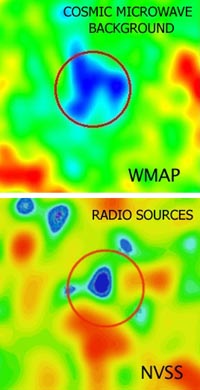Astronomers have come to know that the universe appears to have a foamlike consistency. That is, galaxies are arranged as if they lie along giant bubbles, with large voids in between. Radio astronomers have now found the largest void yet, measuring nearly a billion light-years across toward the constellation Eridanus.

The "big nothing" in the constellation Eridanus. (The circles are 10° across.)
L. Rudnick & others / NRAO / AUI / NSF / NASA
Lawrence Rudnick, Shea Brown, and Liliya R. Williams (University of Minnesota) announced their findings yesterday, which will appear in the Astrophysical Journal. The team studied data from NRAO VLA Sky Survey, hundreds of thousands of separate observations amounting to nearly the entire sky as seen by the Very Large Array radio telescope in New Mexico.
The astronomers pored over the data to examine a "cold spot" in the observations of the cosmic microwave background (CMB) as seen by NASA's Wilkinson Microwave Anisotopy Probe (WMAP) satellite. Rudnick explains, "Although our surprising results need independent confirmation, the slightly colder temperature of the CMB in this region appears to be caused by a huge hole devoid of nearly all matter roughly 6 to 10 billion light-years from Earth."
For more details, see the NRAO press release (or read the study itself).
This void is not to be confused with the giant black rectangle found in the new Sky view of Google Earth.
 0
0
Comments
You must be logged in to post a comment.